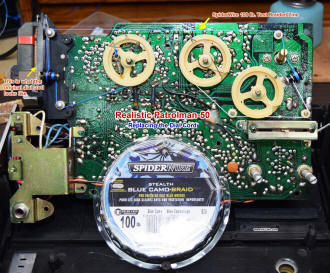|
<Previous
Next>
 In all my years of repairing and restoring
old radios, I have never had the occasion to re-string a dial cord. There are many
variations on dial cord construction and diameter, but there are even more variations
in that way the path around the tuning shaft, tuning elements, and indicator dials
are implemented. Larger radios with lots of room in them are relatively easy to
re-string and usually take a fairly straightforward path, but smaller portable multiband
radios like my 1970's-vintage Realistic (Radio Shack, Tandy) Patrolman-50
are a bit of a challenge, as I found out recently. A Web search on recommendations
for how to replace dial cords results mostly in frustrated handymen who have seemingly
given up on the job. It is easy to understand why, especially on a ridiculously
complicated routing scheme. In all my years of repairing and restoring
old radios, I have never had the occasion to re-string a dial cord. There are many
variations on dial cord construction and diameter, but there are even more variations
in that way the path around the tuning shaft, tuning elements, and indicator dials
are implemented. Larger radios with lots of room in them are relatively easy to
re-string and usually take a fairly straightforward path, but smaller portable multiband
radios like my 1970's-vintage Realistic (Radio Shack, Tandy) Patrolman-50
are a bit of a challenge, as I found out recently. A Web search on recommendations
for how to replace dial cords results mostly in frustrated handymen who have seemingly
given up on the job. It is easy to understand why, especially on a ridiculously
complicated routing scheme.

Realistic Patrolman-50 Multiband Radio

Broken Dial Cord

New Dial Cord Installed
My only guess as to the need for the multiple pulleys and specific number of
wraps around each is because of the need to maintain very solid contact while tuning
four separate variable capacitors to handle the AM, FM, Aircraft, VHF Low and High,
and UFH bands. In the olden days, repair shops usually had documentation from the
manufacturer showing how to re-string the dial cord. If all that is needed is a
couple wraps around the tuning knob shaft and once around a variable tuning capacitor,
it would be a no-brainer. The Patrolman-50, however, has a unique configuration
with a set of pulleys (aka idler, bobbin, or sheave) that each has a dual-diameter
bobbin bound together on the shaft. This creates a situation where as the pulley
rotates, the dial cord winds onto or off of (depending on direction of rotation)
the larger diameter pulley at a greater rate then that of the smaller diameter pulley.
After a few failed attempts at re-stringing, I figured out that this setup helps
keep the dial cord tight around the tuning capacitor pulleys while providing slack
on the back side to prevent binding. It facilitates keeping the entire path at the
proper tension. After a few cycles back and forth between the tuning extremities,
the spring at the end of the dial cord settled into an optimal position.
Fortunately for me, the Patrolman-50's dial cord broke along the path near to
where it connected to the indicator. That allowed me to photograph the original
configuration of the dial cord path before removing it for replacement. I also made
a hand sketch of the path with direction and number of turns around each point.
Unfortunately, though, it was at those darn dual diameter pulleys where the cord
unwound enough to be uncertain about the number of turns on each bobbin. That's
where the difficulty arose with re-winding because there was just enough room on
each section to hold only the required number of turns or else the cord would stack
on itself and bind. It took probably four or five rounds of trial and error to figure
it out. With great relief I finally got the dial cord turns to fill and empty the
bobbins in the correct ratio, and then magically the entire tuning path worked without
any slippage. Actually, the system is designed to accommodate some slip at the ends
of the travel in order to prevent some dummkopf from breaking the cord or a component
while continuing to crank the tuning knob after reaching the end of the tuning range
(no, that's not how I broke it).
Authentic dial cord can be purchased online, but it costs about ten dollars for
a few feet - not enough to allow for screwing up a couple times. Once you tie off
the ends and try the operation, you cannot re-use the dial cord since there will
not be enough to work with on another attempt, and you cannot tie a knot in it.
Yes, I tried a temporary knot, but that did not work for me. Anyway, since the original
dial cord measured about 0.018" in diameter, I bought some 100-pound-test braided
SpiderWire (SCS100BC-200) that is almost exactly the same size. That stuff is really
expensive, and the smallest spool I could find was 200 yards, so there is a lot
left over. I'm not a fisherman and will never use that much, so if you need some
for a dial cord, let me know and I'll send you a few yards for just the cost of
postage. Since SpiderWire is fairly slick, I ran what I used past some 600 grit
sandpaper a few times and then cleaned it with isopropyl alcohol. I also used some
of Melanie's violin bow rosin to make it a bit stickier where it wraps around the
tuning knob shaft. The radio tunes very easily with the setup.
 Dial Cord Routing (left side)

The Patrolman-50 has a jack for connecting an external antenna, which helps for
the VHF and UFH bands.

Right Side
|
 Dial Cord Routing (right side)

Patrolman-50 Radio Bands:
AM: 540-1620 kHz
FM: 88-108 MHz
VHF Air: 108-135 MHz
VHF Hi: 144-174 MHz
VHF Lo: 30-50 MHz
UHF: 450-512 MHz

Back
|
 Printed Circuit Board (Component Side)

Applying Violin Rosin to Dial Cord

Left Side
|
Posted September 10, 2018
|



























 "
"












